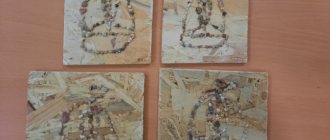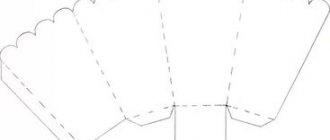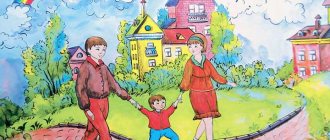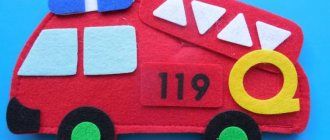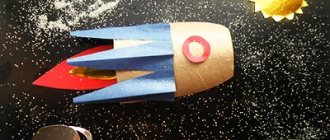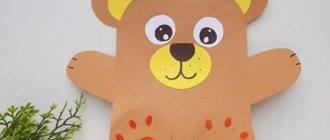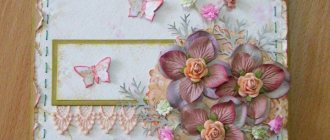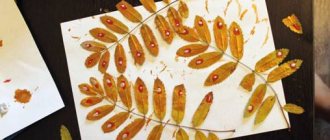Applique city
The “City” applique made of colored paper will be a worthy decoration for any classroom and any room in the apartment. Even the smallest child can cope with its production,
if you help him overcome some difficulties.
Applique city
It is better to take cardboard in a light blue shade as the basis for the application. Against this background, the “City” application will look most organic. At the first stage of work, we glue a fairly wide black stripe to the bottom of this sheet (folded lengthwise).
In the center of this strip we glue a narrow (distributive) strip of white color. It turns out to be a road.
Road
Above it we glue an uneven strip of light green color. This will be the lawn. Cut out four rectangles from beige, light orange or brown paper. We make four square slits in each of them. The result is multi-storey houses, which we glue to the main background - on the “lawn”.
Lawn with houses
We cut out silhouettes of Christmas trees from green corrugated paper, and stems from brown paper. We glue Christmas trees between the houses.
Christmas trees
We cut out trapezoidal roofs for houses from pale yellow corrugated cardboard. Glue them. We cut out a traffic light from black paper and glue it next to the road. Opposite it, we lay out a pedestrian crossing with pieces of a white stripe.
Traffic light and pedestrian crossing
Cut out two cars from paper of different colors. We send them along the road in different directions.
Cars
All that remains is to decorate our urban landscape: cut out flowers from colored paper and plant them on the lawn. We make small clouds from white paper, napkins or cotton pads and stick them on the sky.
Flowers and clouds
Between the clouds we place in the sky a bright, radiant sun cut out from a sheet of yellow paper.
Application favorite city
Our application on the theme “City” is ready! In front of us on the table lies a simple, but clearly recognizable landscape. If desired, you can make various variations of this picture - for example, evening and night views. To do this, you will only need to change the main background and the design of the sky.
Source: https://montessoriself.ru/applikatsiya-gorod/
Project "My Petersburg"
Project type: informational and creative. By timing: short-term (from 19.05 to 30.05). Project participants: middle school children. The project also provides for the active participation of parents of students.
Problem: children’s ignorance about the sights, diversity and features of architectural buildings; lack of culture of behavior in your hometown. Project goal: Implementation of an integrated approach to raising children in the spirit of patriotism, introducing preschoolers to the history and culture of their native city of St. Petersburg, its attractions; nurturing love and affection for one’s hometown. Project objectives: 1. Create conditions for the perception of information about the historical past and cultural appearance of the native city. 2. To familiarize preschoolers with historical, cultural, geographical, natural and environmental uniqueness. 3. Cultivate a sense of pride in St. Petersburg, an emotional and value-based attitude towards your city.
Forms and methods of work:
Thematic classes, presentations, conversations , targeted walks, watching cartoons, situations, memorizing poems, board games, observations, reading works of art, role-playing, didactic games, looking at illustrations.
Reason for development:
The project ensures the achievement of specific results in a short period of time.
The implementation of the project ensures the active participation of children, parents and teachers.
The project can be implemented as part of a joint activity. Preparatory stage: - select illustrations, paintings, slides, recordings on the topics of the lessons; — select children’s literature on the subject of the project; - select samples of Russian folk crafts; — develop a script for a literary and musical festival for City Day “My City - St. Petersburg”; - prepare material for visual arts. Project content: - conduct cognitive cycle classes to familiarize yourself with the environment; — organize creative activities for children: games, drawing, appliqué, etc.;
- together with the children, make a collective work: “Finland Station” - involve children and parents in collecting material for the design of albums: the photo exhibition “Sights of our city”; — to hold a literary and musical festival “My City is St. Petersburg.”
Expected Result:
Clarification and addition about the sights of the city and the culture of behavior in the city.
Have an idea of events aimed at developing and improving the city.
To consolidate knowledge about the types of bridges and buildings; know their names; be able to distinguish and find similarities in varieties of architectural structures.
Have discipline skills and a culture of behavior in public places of the city.
Develop a humane attitude and patriotic feeling towards your city.
Project implementation:
1. Cognitive cycle classes to familiarize yourself with the environment:
Topic 1. “Bridges of St. Petersburg” - a lesson in the form of a presentation, introducing children to the types of bridges in the city: their features, differences, symbols.
Topic 2. “Sights of the city” - a lesson in the form of a presentation, viewing slides, getting acquainted with the features of the city, a brief history and a memorable symbol of the architectural structure.
Topic 3 . “Finland Station” - a lesson in the form of a presentation, a short story about its origin, characteristic features and distinctive features.
Topic 4. “Peter and Paul Fortress” - a brief history of its origin, highlighting its characteristic features, and the significance of the architectural structure.
Topic 5 . “Nevsky Prospekt” is the main street of the city, according to old ideas “a street for the rich,” famous buildings, features, comparison with modern Nevsky Prospekt.
Topic 6. “ Rivers of St. Petersburg” - a lesson in the form of a presentation, types of rivers and their names.
Topic 7. “ Ancient Petersburg” - introducing children to “old” Petersburg, slide - pictures depicting the sights of the city in the past; comparison with the “new” Petersburg, similarities and differences.
2. Visual activities for children:
Topic 1. “ City sights ” - coloring pictures, conveying exact colors, highlighting architectural features.
Topic 2 . “Finland Station” - applique made from waste material and plants; teamwork.
Topic 3. “Peter and Paul Fortress” - modeling from salt dough, highlighting characteristic features and memorable features.
3. Children's play activities
• Didactic games: — “Recognize our flag (coat of arms)”; - “Foreigner” - “Whose suit?”; - “I’ll name it, and you guess”;
- “Guess the picture.”
• Board games:
— "Labyrinth";
- “Puzzles”, “Dominoes”.
• Outdoor games: — “Lions of stone”; — “Burners”; - “From bump to bump.”
4. Reading fiction: • tales: - “The Tale of How Our City Was Born” - “Savior on Spilled Blood”; — “Peter and Paul Fortress” — “Winter Palace”; — “The Bronze Horseman” — “Decembrist Square”; — “The Secret of the Palace Bridge.”
• Stories, novellas: - “This city of Leningrad” Budogoskaya L., Vladimirov Y.; — A. Ishimova “History of Russia in stories for children” (separate chapters); - N. Nosov “Metro”.
• Poems about St. Petersburg - S. Skachenkov “At Night on Nevsky”; "Night Wind"; "Petrodvorets"; — V. Bryusov “To the Bronze Horseman”; — A. Fatyanov “Petersburg”, “White Nights”;
— V. Lelina “Lion's Bridge.”
5. Participation of parents in the implementation of the project: ; — collecting material for the design of albums: “Cities of Russia”;
— photo of the exhibition “Attractions of our city”;
— collection of coloring books on the theme: “My Petersburg.”
The result of the project: - album design, “Cities of Russia”; — photo exhibition “Attractions of our city”; — Literary and musical festival “My city is St. Petersburg.”
DIY “Cardboard City” craft
To create a themed gift for loved ones, you can make “City” paper and cardboard crafts. To create such a city, the following tools are needed:
- glue;
- scissors;
- thick cardboard;
- thick marker;
- a simple pencil;
- acrylic paints;
- brush;
- glass of water.
- You need to take thick cardboard and cut out the silhouette of a building from it. Thus, it is necessary to create several houses.
- Draw the resulting template in the middle with a simple pencil.
- Draw a small line with a pencil next to the main one to the middle of the house. Cut out the resulting strip of cardboard.
- On some houses it is necessary to cut out the middle from the top or bottom of the house, since in the future the two parts will be connected to each other.
- We connect the two halves of the house.
- We draw out the location of windows and doors on the house with a simple pencil.
- We paint both parts of the house with acrylic paints.
- Let's connect them together.
- In a similar way, we produce several houses of varying thickness, height, and width.
- We take a sheet of Whatman paper and draw the markings of the lawn and paths with a simple pencil.
- We paint whatman paper with acrylic paints.
- We place the resulting houses on a sheet of Whatman paper.
You and your child can make paper crafts and create a city in the same way: first we draw and paint the houses with paints, then we cut out and glue the bottom part of the houses to a sheet of white paper.
Thus, in the process of creative activity, the child will develop the importance and significance of such a festive event as City Day.
Source: https://womanadvice.ru/podelki-na-temu-moy-gorod
